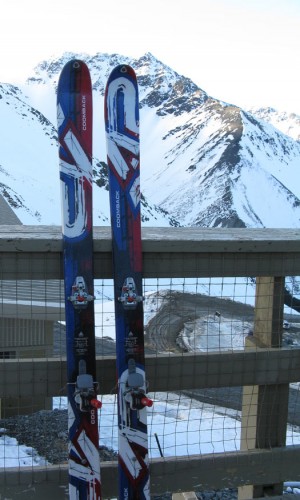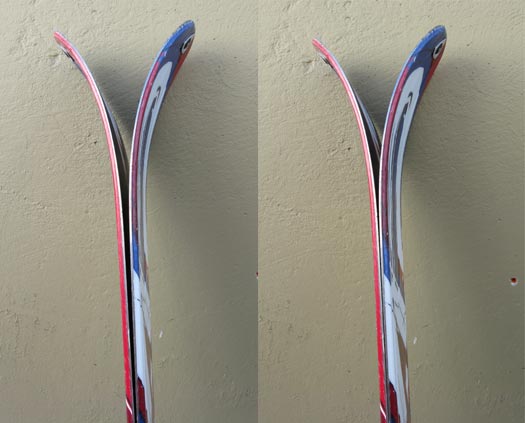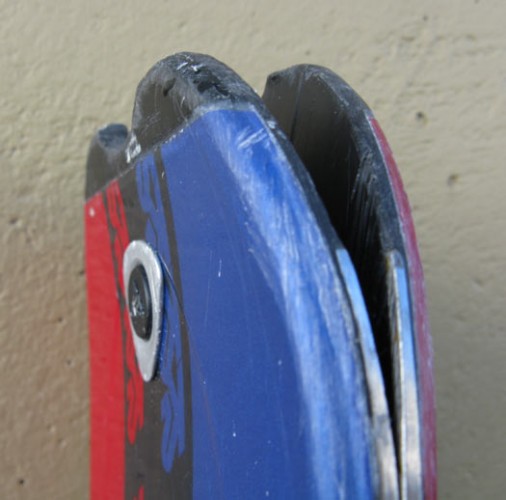
The Coombacks
One of the great things about going to New Zealand was that I was able to take any ski I wanted from the stack in our storage shed, since nobody (as in DAD) else was going to be using them much this summer.
For my main plank I chose the new K2 Coomback. I needed an upgrade from my old first generation Black Diamond Verdicts, and the 174 cm Coombacks seemed like a good choice. They’re slightly longer, have a rockered tip, and are a little fatter.
I knew I better grab them when I had the chance, so I stuffed them in the ski bag when you-know-who wasn’t looking.
My first-gen Verdicts laid down the law in powder, but on hardpack they were unfun. I expected the same from the Coombacks, so I took some skinnier Mount Bakers for stuff that wasn’t soft and fluffy. It turns out, however, that I have been riding the Coombacks every day, both for backcountry skiing and in-area. They are effortless in powder, and do incredibly well in everything else.

Coombacks get ready for fun at Temple Basin
I tried the Coombacks in some breakable crust a few days ago and was amazed at how they ruled. The width and tip rocker kept the tips out from under the crust perfectly. I could carve fun large radius turns almost like it was powder, while everyone else was struggling. They also do ok on groomers and crud. However, they get thrown around a little bit if you try to bust icy crud at high speeds, probably due to their light weight and soft tip. However, if you slow down a bit (something I don’t like to do) they work great in almost anything.

The tip rocker becomes much more obvious when you squeeze the skis together (left) than when the skis are sitting normaly (right).
Even with great performance, the Coombacks are still nice and light, weighing in at only a few ounces more than some of my earlier backcountry skis, but longer and of course wider. (We will publish weight when I return from NZ and can verify that they weigh the same as the full production version). They truly are specifically made for backcountry skiing. Witness the tip and tail holes; skin notch in the back; flat tails. In my opinion flat tails are it for backcountry skiing, you can cut snowpit walls easily, you can put your skis on your pack way quicker, and stabbing your skis into the snow for use as a quickie anchor is a snap instead of a stupid looking struggle.

Flat tail, well made tail holes, and a skin notch, nice!
I noticed the Coombacks top sheet material seems to be softer than some other skis I’ve used. We got in touch with K2 about this, and they assured me that what they used on the Coomback is what they used on the Coomba and all other backcountry skis for years. They said some companies use harder top skins, and some use softer. I think what got me going on this is I’ve not used many k2 skis, and the old Verdicts had really tough skin, so I noticed. Now that I’m educated, I’d say this is a non issue.
Perhaps more importantly in terms of downsides, the Coombacks might be a bit soft for some bigger/agro skiers, but they work for me. How “soft” a ski feels is of course somewhat a function of length as well, so as always, if in doubt demo first.
Yep, get ready to burn some plastic out of your wallet — Coombacks are sweet. They have the best ski performance of any ski I have owned (considering I have only owned backcountry skis my whole life), while still being pretty light. In other words, they are indeed a terrific lightweight (for their width) backcountry powder ski. Even better, they bust through bad snow in a way that belies their lack of mass. Thus, Coombacks will be my go-to ski for variable snow, as well as for getting big vertical of human powered backcountry skiing pow. I also expect them to work magic for ski mountaineering in variable conditions. Only problem is, I wonder when DAD is going to notice they’re not in the shed?
Louie Dawson earned his Bachelor Degree in Industrial Design from Western Washington University in 2014. When he’s not skiing Mount Baker or somewhere equally as snowy, he’s thinking about new products to make ski mountaineering more fun and safe.
